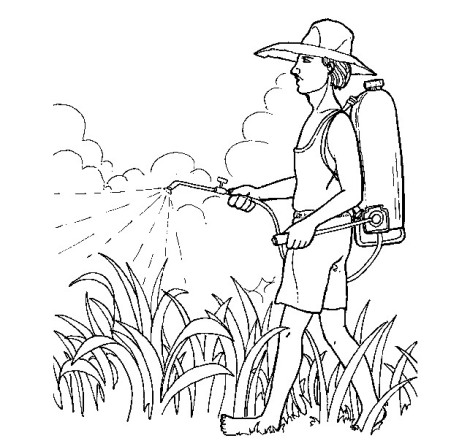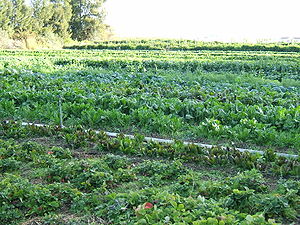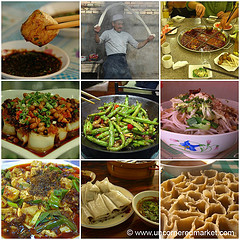 Organic farming is a form of agriculture that relies on crop rotation, green manure, compost, biological pest control, and mechanical cultivation to maintain soil productivity and control pests, excluding or strictly limiting the use of synthetic fertilizers and synthetic pesticides, plant growth regulators, livestock feed additives, and genetically modified organisms. Since 1990, the market for organic products has grown at a rapid pace, to reach $46 billion in 2007. This demand has driven a similar increase in organically managed farmland. Approximately 32.2 million hectares worldwide are now farmed organically, representing approximately 0.8 percent of total world farmland. In addition, as of 2007 organic wild products are harvested on approximately 30 million hectares .
Organic farming is a form of agriculture that relies on crop rotation, green manure, compost, biological pest control, and mechanical cultivation to maintain soil productivity and control pests, excluding or strictly limiting the use of synthetic fertilizers and synthetic pesticides, plant growth regulators, livestock feed additives, and genetically modified organisms. Since 1990, the market for organic products has grown at a rapid pace, to reach $46 billion in 2007. This demand has driven a similar increase in organically managed farmland. Approximately 32.2 million hectares worldwide are now farmed organically, representing approximately 0.8 percent of total world farmland. In addition, as of 2007 organic wild products are harvested on approximately 30 million hectares .
Organic agricultural methods are internationally regulated and legally enforced by many nations, based in large part on the standards set by the International Federation of Organic Agriculture Movements (IFOAM), an international umbrella organization for organic organizations established in 1972. IFOAM defines the overarching goal of organic farming as follows:
“Organic agriculture is a production system that sustains the health of soils, ecosystems and people. It relies on ecological processes, biodiversity and cycles adapted to local conditions, rather than the use of inputs with adverse effects. Organic agriculture combines tradition, innovation and science to benefit the shared environment and promote fair relationships and a good quality of life for all involved..”
The organic movement began in the early 1930s and early 1940s as a reaction to agriculture’s growing reliance on synthetic fertilizers. Artificial fertilizers had been created during the 18th century, initially with superphosphates and then ammonia derived fertilizers mass-produced using the Haber-Bosch process developed during World War I. These early fertilizers were cheap, powerful, and easy to transport in bulk. Similar advances occurred in chemical pesticides in the 1940s, leading to the decade being referred to as the ‘pesticide era’.
Sir Albert Howard is widely considered to be the father of organic farming. Further work was done by J.I. Rodale in the United States, Lady Eve Balfour in the United Kingdom, and many others across the world. As a percentage of total agricultural output, organic farming has remained tiny since its beginning. As environmental awareness and concern increased amongst the general population, the originally supply-driven movement became demand-driven. Premium prices from consumers and in some cases government subsidies attracted many farmers into converting. In the developing world, many farmers farm according to traditional methods which are comparable to organic farming but are not certified. In other cases, farmers in the developing world have converted out of necessity[citation needed]. As a proportion of total global agricultural output, organic output remains small, but it has been growing rapidly in many countries, notably in Europe.
Much before the awareness about the Organic farming through the movements began, there was a well developed Organic farming system in India. Ancient Indian texts describe the methods of Organic farming. This is being practiced even today in many of the villages in India. Sanjeevan system is an example of such organic farming method.
 The markets for organic products are strongest in North America and Europe, which as of 2001 are estimated to have $6 and $8 billion respectively of the $20 billion market (2003:6). However, as of 2007 organic farmland is distributed across the globe. Australasia has 39% of the total organic farmland with Australia’s 11.8 million hectares, but 97 percent of this land is sprawling rangeland (2007:35), which results in total sales of approximately 5% of US sales (2003:7). Europe has 23 percent of total organic farmland (6.9 million hectares), followed by Latin America with 19 percent (5.8 million hectares). Asia has 9.5 percent while North America has 7.2 percent. Africa has a mere 3 percent. See also Organic farming by country.
The markets for organic products are strongest in North America and Europe, which as of 2001 are estimated to have $6 and $8 billion respectively of the $20 billion market (2003:6). However, as of 2007 organic farmland is distributed across the globe. Australasia has 39% of the total organic farmland with Australia’s 11.8 million hectares, but 97 percent of this land is sprawling rangeland (2007:35), which results in total sales of approximately 5% of US sales (2003:7). Europe has 23 percent of total organic farmland (6.9 million hectares), followed by Latin America with 19 percent (5.8 million hectares). Asia has 9.5 percent while North America has 7.2 percent. Africa has a mere 3 percent. See also Organic farming by country. In recent years both Europe (2007: 7.8 million hectares/European Union: 7.2 million hectares) and North America (2007: 2.2 million hectares) have experienced strong growth in organic farmland. However, this growth has occurred under different conditions. While the European Union has shifted agricultural subsidies to organic farmers in recognition of its environmental benefits, the United States has taken a free market approach[19]. As a result, as of 2007 4 percent of the European Union’s farmland was organically managed compared to just 0.6 percent of United States farmland (Willer/Kilcher 2009). IFOAM’s most recent edition of The World of Organic Agriculture: Statistics and Emerging Trends 2009 lists the countries which had the most hectares in 2007. The country with the most organic land is Australia with more than 12 million hectares, followed by Argentina, Brasil and the US. In total 32.2 million hectares were under organic management in 2007. For 1999 11 million hectares of organically managed land are reported (Willer/Kilcher 2009).
In recent years both Europe (2007: 7.8 million hectares/European Union: 7.2 million hectares) and North America (2007: 2.2 million hectares) have experienced strong growth in organic farmland. However, this growth has occurred under different conditions. While the European Union has shifted agricultural subsidies to organic farmers in recognition of its environmental benefits, the United States has taken a free market approach[19]. As a result, as of 2007 4 percent of the European Union’s farmland was organically managed compared to just 0.6 percent of United States farmland (Willer/Kilcher 2009). IFOAM’s most recent edition of The World of Organic Agriculture: Statistics and Emerging Trends 2009 lists the countries which had the most hectares in 2007. The country with the most organic land is Australia with more than 12 million hectares, followed by Argentina, Brasil and the US. In total 32.2 million hectares were under organic management in 2007. For 1999 11 million hectares of organically managed land are reported (Willer/Kilcher 2009).